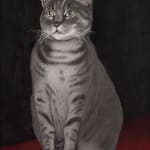Jan Ouwersloot (1902-1975)
Born on October 27, 1902, in Gouda, Jan Ouwersloot was a self-taught artist who moved to Amsterdam in 1923 to pursue his passion for painting.[1] Without the network of the art academy, Ouwersloot struggled to make a living of his studio practice. From 1930 until his retirement in 1962, he worked for a company selling drugstore supplies, dedicating his spare time to painting. Due to his sedulous style and limited leisure schedule, Ouwersloot’s body of work remained small but singular. From the late 1920s throughout the 1960s, he was a member of De Onafhankelijken (The Independents), Amsterdam’s counterpart to Paris’s Salon des Indépendants.
In 1925, the Mannheimer Kunsthalle’s legendary Neue Sachlichkeit (New Objectivity) exhibition became a cultural signifier of new realism popular throughout Europe in the interwar period. Rooted in the developments in Germany, Italy, and Russia, this hyper-realist approach to painting gained popularity despite being often dismissed as regressive compared to the avant-garde experimentation of pre-1920s. Nevertheless, New Objectivity became synonymous with the interbellum, mirroring the era’s cultural and pollical upheavals. In the Netherlands, the movement known as Nieuwe Zakelijkheid, found a champion in Ouwersloot. His urban nocturnal landscapes, featuring gas stations, train tracks and deserted streets, rendered in a naïvely realistic style, blurring the boundaries between topographical accuracy and imaginative fantasy.
While the New Objectivity’s preeminent paintings were portraits and still lifes, with a limited arsenal of props such as eggshells, pears, pipes, bottles, and skulls, Ouwersloot seldom explored these genres. Instead, his street scenes embodied a stillness of life, evoking a hermetic yet dreamlike idiosyncrasy. An exception is the featured feline portrait of the family’s beloved tabby. Although the cat’s name may be lost to history, its charm and character are vividly immortalized, a testament to Ouwersloot’s mysterious meticulousness.
[1] Carel Blotkamp, Magie en zakelijkheid. Realistische schilderkunst in Nederland 1925-1945,
Provenance
Jan Ouwersloot, by descent to his daughter
Her sale, 11 April 2020, lot 36031571
Private collection, The Netherlands



